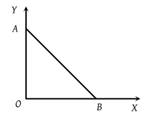As per this diagram a point charge +q is placed at the origin O. Work done in taking another point charge –Q from the point A [co-ordinates (0, a)] to another point B [co-ordinates (a, 0)] along the straight path AB is

(1) Zero
(2)
(3)
(4)

Two charges \(q_1\) and \(q_2\) are placed \(30~\text{cm}\) apart, as shown in the figure. A third charge \(q_3\) is moved along the arc of a circle of radius \(40~\text{cm}\) from \(C\) to \(D.\) The change in the potential energy of the system is \(\dfrac{q_{3}}{4 \pi \varepsilon_{0}} k,\) where \(k\) is:

| 1. | \(8q_2\) | 2. | \(8q_1\) |
| 3 | \(6q_2\) | 4. | \(6q_1\) |
Two thin wire rings each having a radius R are placed at a distance d apart with their axes coinciding. The charges on the two rings are +q and –q. The potential difference between the centres of the two rings is -
(1) Zero
(2)
(3)
(4)
A hollow metallic sphere of radius R is given a charge Q. Then the potential at the centre is -
(1) Zero
(2)
(3)
(4)
A capacitor is charged by using a battery which is then disconnected. A dielectric slab is then slipped between the plates, which results in -
(1) Reduction of charge on the plates and increase of potential difference across the plates
(2) Increase in the potential difference across the plate, reduction in stored energy, but no change in the charge on the plates
(3) Decrease in the potential difference across the plates, reduction in the stored energy, but no change in the charge on the plates
(4) None of the above
The capacity of a condenser is 4 × 10–6 farad and its potential is 100 volts. The energy released on discharging it fully will be -
(1) 0.02 Joule
(2) 0.04 Joule
(3) 0.025 Joule
(4) 0.05 Joule
The insulated spheres of radii R1 and R2 having charges Q1 and Q2 respectively are connected to each other. There is -
(1) No change in the energy of the system
(2) An increase in the energy of the system
(3) Always a decrease in the energy of the system
(4) A decrease in the energy of the system unless Q1R2 = Q2R1
The energy stored in a condenser of capacity C which has been raised to a potential V is given by -
(1)
(2)
(3) CV
(4)
If two conducting spheres are separately charged and then brought in contact -
(1) The total energy of the two spheres is conserved
(2) The total charge on the two spheres is conserved
(3) Both the total energy and charge are conserved
(4) The final potential is always the mean of the original potentials of the two spheres
Eight drops of mercury of equal radii possessing equal charges combine to form a big drop. Then the capacitance of bigger drop compared to each individual small drop is
(1) 8 times
(2) 4 times
(3) 2 times
(4) 32 times






